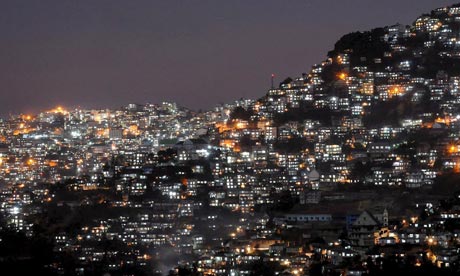3G services are finally set to revolutionize Indian telecom landscape. With 3G spectrum allocation over, telcos are now gearing up to roll out the services to users. And very soon Indian consumers will be able to do so much more than just voice and text messaging.
3G will allow mobile users to watch TV, play online games, download videos and listen to streaming music straight on their mobile screens.
But in case your handset is still not 3G ready or you are struggling to find one that suits your pocket, here are some 3G phones in the sub-Rs 10,000 range.

Samsung S5620 Monte

Samsung recently expanded its touchscreen phone line-up in India with the launch of 3G-ready S5620 Monte.
Featuring a 3-inch TFT touchscreen display, the phone comes equipped with Smart unlock, accelerometer sensor, 3.15 megapixel camera and geo-tagging.
Other features include smile detection capability, Bluetooth, 3.5mm audio jack, Google Maps, Stereo FM Radio and image editing applications.
The phone promises to offer 9 hours, 42 minutes of talk time. The phone's internal memory is 200MB which can be expanded using a microSD card. Samsung S5620 is priced at Rs 8,850 approximately.
LG GU285

Korean electronics giant LG has extended its mobile portfolio with the addition of 3G capable LG GU285. Sporting a 2.2-inch touchscreen screen, the phone packs two cameras - a 1.3 megapixel at the back and a VGA camera on the front side for video calling. The phone supports GPRS/EDGE and is 3G ready.
Other features include expandable memory upto 8GB, music playback, FM Radio and ‘Try & Games’ which has games like Sudoku, and Ferrari GT.
LG GU285 is priced at Rs 6,000.
Nokia 2730 classic

Finnish cellphone maker too offers a low-price 3G phone in its India line-up. Called Nokia 2730 classic, the phone is equipped with Nokia's Ovi Mail, Nokia Messaging, Nokia Life Tools and browsing. The phone also comes with an integrated Opera mini browser.
Available in black and dark magenta colour, the handset measures 109.6 mm x 46.9 mm x 14.4 mm and weighs 87.7 grams. The battery life offers maximum of 7.4 hours talktime and 16.5 days standby time.
The 3G capable phone comes with A2DP Bluetooth, USB port with microUSB but with no WLAN and infrared. The handset also packs a 2 megapixel camera with 1600 x 1200 pixels with video recording of 176 x 144 at 10 fps(frames per second).
As for memory, Nokia 2730 Classic has 30MB internal memory which supports microSD card upto 2GB. The handset is priced at Rs 4,499.
Samsung Metro 3G

Samsung recently added another 3G phone to its India line-up. Called Metro 3G, the phone has metallic exterior and is 11.9mm in thickness.
Samsung Metro 3G provides users with easy access to nine social networking sites, including Facebook, YouTube, Flickr, Picassa, Friendster and Photobucket.
Metro 3G also comes equipped with a chat messenger and supports GTalk, AIM and Palringo chat. Other features include 3.2 megapixel camera, with Smile shot and Panorama shot technology, and Bluetooth 2.1 which offers wireless connectivity to headsets, printers as well as mobile and PC devices.
The mobile phone has 105MB internal memory and a microSD support for upto 16GB. Metro 3G is also the first phone in Metro series to offer support in nine regional languages.
The phone is priced at Rs 8,250 approximately.
LG Cookie Plus GS500v

LG has refreshed its touchscreen lineup in the country with the launch Cookie Plus GS500v.
The 3G-capable model LG Cookie Plus GS500v sports a 3-inch LCD touchscreen display and has a 3 megapixel camera. The phone's key features include one touch social networking, editable screen shot, MMS and a 3-way user interface.
The phone comes with 3.5 mm jack and connectivity options include Bluetooth 2.1 and micro USB. The handset also comes with Facebook auto update feature. The phone has 30MB of internal memory that can be expanded up to 8GB.
LG Cookie Plus GS500v is priced at Rs 7,999.
Nokia C5

Nokia recently added 3G phone to its C-series in India called Nokia C5. Sporting a 2.2-inch display with 240 x 320 pixels, C5 comes with 3.5 megapixel camera with LED Flash and video recording VGA at 15 fps (frames per second).
The phone also offers support for Nokia Ovi Maps which enables free global navigation. Running on Symbian OS 9.3, the phone comes pre-loaded with a 2GB memory card. The memory can be expanded upto 16GB.
Other key features include front-facing VGA camera, Class 32 GPRS and EDGE, FM radio, 3G support, Bluetooth 2.0 with A2DP and microUSB 2.0 port.
The phone is priced at Rs 7,999.
INQ Mini 3G and Chat 3G

UK-based handset maker INQ recently added two 3G handsets in India -- INQ Mini 3G and Chat 3G. Measuring 114.5 x 61 x 12.8 mm, INQ Chat 3G mobile comes with QWERTY keypad. The device supports push email, Facebook, Twitter and IM.
The other key features include QVGA display, music player and a 3.2 megapixel autofocus camera. The phone has 100MB of internal memory and can be expanded upto 4GB. INQ Chat 3G is priced at Rs 7,600.
The second handset Mini 3G comes with a 2.2 inch QVGA TFT display. The integrated INQ apps boast of Facebook, Skype, Twitter, and Instant Launcher.
The device features a 2 megapixel camera, on board 128MB memory and expandable memory card slot support upto 4GB capacity. It also comes with Bluetooth 2.0 + EDR, USB 2.0 and 1150 mAh battery. INQ mini 3G is available for Rs 5,400.
HTC Smart

Priced below Rs 10,000, HTC Smart is the cheapest device ever launched by the company in the Indian market. Sporting a 2.8-inch TFT-LCD touchscreen with QVGA resolution, the phone comes with 3.5 mm stereo audio jack, HTC Sense UI and a 3 megapixel camera.
Other features include GSM/GPRS/EDGE, Bluetooth 2.0, HSDPA/WCDMA and microSD memory card with SD 2.0 support. Smart promises 370 minutes of talktime for WCDMA and upto 450 minutes of talktime for GSM.
The phone has a 300 MHz processor with 256MB RAM and 256MB ROM. The mmory can be expanded upto 16GB. The smartphone is powered by Qualcomm’s Brew operating system.
Smart offers support for Bluetooth withA2DP, 3G, Mini USB connectivity, 3.5 mm headphone jack, FM radio with RDS and music player. However, Smart is not Wi-Fi enabled.







 Lad Phawa's Fields - now a water storage area
Lad Phawa's Fields - now a water storage area














